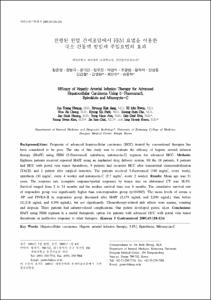KUMEL Repository
1. Journal Papers (연구논문)
1. School of Medicine (의과대학)
Dept. of Internal Medicine (내과학)
진행된 원발 간세포암에서 FEM 요법을 이용한 국소 간동맥 항암제 주입요법의 효과
- Alternative Author(s)
- Jang, Byoung Kuk; Chung, Woo Jin; Park, Kyung Sik; Cho, Kwang Bum; Hwang, Jae Seok; Ahn, Sung Hoon; Kim, Gab Chul; Kim, Young Hwan; Choi, Jin Soo; Kwon, Jung Hyeok
- Journal Title
- Korean Journal of Gastroenterology
- ISSN
- 1598-9992
- Issued Date
- 2005
- Keyword
- Hepatocellular carcinoma(간세포암); Hepatic arterial infusion therapy(국소 간동맥 항암제 주입요법); 5-FU; Epirubicin; Mitomycin-C
- Abstract
- Background/Aims: Prognosis of advanced hepatocellular carcinoma (HCC) treated by conventional therapies has been considered to be poor. The aim of this study was to evaluate the efficacy of hepatic arterial infusion therapy (HAIT) using FEM (5-fLuorouracil, epirubicin, mitomycin-C) regimen for advanced HCC. Methods: Eighteen patients received repeated HAIT using an implanted drug delivery system. Of the 18 patients, 8 patients had HCC with portal vein tumor thrombosis, 9 patients had recurrent HCC after transarterial chemoembolization (TACE) and 1 patient after surgical resection. The patients received 5-fluorouracil (330 mg/m2, every week), epirubicin (30 mg/m2, every 4 weeks) and mitomycin-C (2.7 mg/m2, every 2 weeks). Results: Mean age was 51 years. The response rate (complete response+partial response) by tumor size on abdominal CT was 38.9%. Survival ranged from 2 to 24 months and the median survival time was 8 months. The cumulative survival rate of responders group was significantly higher than non-responders group (p=0.0385). The mean levels of serum a -FP and PIVKA-II in responders group decreased after HAIT (3,179 ng/mL and 2,850 ng/mL) than before (11,218 ng/mL and 4,396 ng/mL), but not significantly. Chemotherapy-related side effects were nausea, vomiting and alopecia. Three patients had catheter-related complications. One patient developed gastric ulcer. Conclusions: HAIT using FEM regimen is a useful therapeutic option for patients with advanced HCC with portal vein tumor thrombosis or ineffective response to other therapies. (Korean J Gastroenterol 2005;45:118-124)
Key Words: Hepatocellular carcinoma; Hepatic arterial infusion therapy; 5-FU; Epirubicin; Mitomycin-C
요약
목적: 이번 연구는 진행된 원발 간세포암 환자에서 FEM 요법을 이용하여 국소 간동맥 항암제 주입요법으로 치료하 여 그 효과와 부작용을 알아보고자 하였다. 대상 및 방법: 대상 환자는 간문맥 혈전증을 동반한 거대 종양이 있거나, TACE 나 수술 후에 다발성으로 재발한 환자들로서 총 18명 이었다. 약물 전달 방법으로 도관 말단을 고유 간동맥에 위 치시키고 우하복부 피하의 주입부로 항암제를 주입하였다. 항암제는 5-FU 330 mg/m2을 1주마다,mitomycin-C 2.7 mg/ m2을 2주마다,epirubicin 30 mg/m2을 4주마다 주입하였다. 4 주를 1주기로 하여 계속 반복하여 치료하였으며 2주기마다 복부CT를 시행하여 치료 효과를 판정하였고,1주기마다 혈 청 a-FP과 PIVKA-II를 측정하였다. 결과: 치료의 반응률은 38.9%였고,치료한 환자들의 중앙 생존기간은 8개월이었다. 그리고 치료 반응군이 비반응군보다 누적생존율이 유의하 게 증가되었다(p=0.0385). 혈청 a-FP와 PIVKA-II는 반응군
에서 치료 전에 비해 치료 후 그 값이 유의하지는 않지만 감소하였다. 치료의 부작용은 오심,구토,탈모,위궤양,도 관의 문제 등이 있었다. 결론: FEM 요법을 이용한 국소 간 동맥 항암제 주입요법은 효과적이고,생존기간의 연장을 기 대해 볼 수 있으며 TACE나 PEIT,수술 치료 등 근치 치료 로 다시 연결해 줄 수 있는 유용한 방법으로 생각한다.
색인단어: 간세포암,국소 간동맥 항암제 주입요법,5-FU, Epirubicin, Mitomycin-C
- Alternative Title
- Efficacy of Hepatic Arterial Infusion Therapy for Advanced Hepatocellular Carcinoma Using 5-Fluorouracil, Epirubicin and Mitomycin-C
- Publisher
- School of Medicine
- Citation
- 황준영 et al. (2005). 진행된 원발 간세포암에서 FEM 요법을 이용한 국소 간동맥 항암제 주입요법의 효과. Korean Journal of Gastroenterology, 45(2), 118–124.
- Type
- Article
- ISSN
- 1598-9992
- Appears in Collections:
- 1. School of Medicine (의과대학) > Dept. of Internal Medicine (내과학)
1. School of Medicine (의과대학) > Dept. of Radiology (영상의학)
- 파일 목록
-
-
Download
 oak-aaa-4592.pdf
기타 데이터 / 389.03 kB / Adobe PDF
oak-aaa-4592.pdf
기타 데이터 / 389.03 kB / Adobe PDF
-
Items in Repository are protected by copyright, with all rights reserved, unless otherwise indicated.